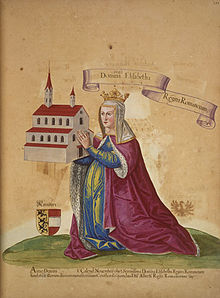Elisabeth of Carinthia, Queen of the Romans
| Elizabeth of Carinthia | |
|---|---|
 Portrait by Anton Boys, 16th century | |
| Queen consort of Germany | |
| Tenure | 27 July 1298 – 1 May 1308 |
| Predecessor | Imagina of Isenburg-Limburg |
| Successor | Margaret of Brabant |
| Duchess consort of Austria | |
| Tenure | 17 December 1282 – 1 May 1308 |
| Predecessor | Gertrude of Hohenberg |
| Successor | Blanche of France |
| Born | c. 1262 Munich, Bavaria |
| Died | 28 October 1312 Königsfelden, Swabia |
| Burial | Saint Paul's Abbey, Carinthia |
| Spouse | Albert I of Germany |
| Issue | Rudolf I of Bohemia Frederick the Fair Leopold I, Duke of Austria Albert II, Duke of Austria Otto, Duke of Austria Anna, Duchess of Breig Agnes, Queen of Hungary Elisabeth, Duchess of Lorraine Catherine, Duchess of Calabria Judith, Countess of Öttingen |
| House | House of Gorizia |
| Father | Meinhard, Duke of Carinthia |
| Mother | Elisabeth of Bavaria |
Elizabeth of Carinthia (also known as Elizabeth of Tyrol; c. 1262 – 28 October 1312), a member of the House of Gorizia (Meinhardiner dynasty), was Duchess of Austria from 1282 and Queen of Germany from 1298 until 1308, by her marriage with the Habsburg king Albert I.
Family
Born in Munich, Bavaria, she was the eldest daughter of Count Meinhard of Gorizia-Tyrol. Her mother was Elizabeth of Bavaria, daughter of the House of Wittelsbach duke Otto II and his wife Agnes, herself a daughter of the Welf count palatine Henry V and Agnes of Hohenstaufen.
Her mother was also the widow of the late Hohenstaufen king Conrad IV of Germany. Therefore, the young Elizabeth was a half-sister of Conradin, King of Jerusalem and Duke of Swabia. Elizabeth was in fact better connected to powerful German rulers than her future husband: a descendant of earlier monarchs, for example Emperor Frederick Barbarossa, she was also a niece of the Bavarian dukes,[1] Austria's important neighbours.
Marriage

She was married in Vienna on 20 December 1274 to Count Albert of Habsburg, eldest son and heir of the newly elected King Rudolf I of Germany, thus becoming daughter-in-law of the King of the Romans and Emperor-to-be. After Rudolf had defeated his rival King Ottokar II of Bohemia in the 1278 Battle on the Marchfeld, he invested his son Albert with the duchies of Austria and Styria at the Imperial Diet in Augsburg on 17 December 1282.
Albert initially had to share the rule with his younger brother Rudolf II, who nevertheless had to waive his rights according to the Treaty of Rheinfelden the next year. Duke Albert and Elizabeth solidified their rule in what was to become the Habsburg "hereditary lands", also with the help of Elizabeth's father Meinhard, who in his turn was created Duke of Carinthia by King Rudolf I in 1286.
Upon the death of Albert's father in 1291, the princes elected Count Adolf of Nassau German king, while Duke Albert himself became entangled in internal struggles with the Austrian nobility. Not until Adolf's deposition in 1298, Elizabeth's husband was finally elected King of the Romans on 23 June 1298. Two weeks later, Adolf was defeated and killed in the Battle of Göllheim. In 1299, Elizabeth was crowned Queen of the Romans in Nuremberg.

On 1 May 1308 her husband was murdered by his nephew John "the Parricide" near Windisch, Swabia (in modern-day Switzerland). After Albert's assassination, Elizabeth had the Poor Clare monastery of Königsfelden erected at the site, where she died on 28 October 1312 and was also buried.[2] Today her mortal remains rest at Saint Paul's Abbey in Carinthia.
Elizabeth was a shrewd and enterprising woman who had some commercial talents. The construction of the Saline plant in Salzkammergut goes back to her suggestion.[3]
Issue
Elizabeth's and Albert's children were:
- Rudolf III (ca. 1282 – 4 July 1307), married but line extinct. He predeceased his father.
- Frederick I (1289 – 13 January 1330). Married but line extinct.
- Leopold I (4 August 1290 – 28 February 1326, Strassburg).
- Albert II (12 December 1298, Vienna – 20 July 1358, Vienna).
- Henry the Gentle (1299 – 3 February 1327, Bruck an der Mur). Married but line extinct.
- Meinhard, 1300 died young.
- Otto (23 July 1301, Vienna – 26 February 1339, Vienna). Married but line extinct.
- Anna 1280?, Vienna – 19 March 1327, Breslau), married:
- in Graz ca. 1295 to Margrave Hermann of Brandenburg;
- in Breslau 1310 to Duke Heinrich VI of Breslau.
- Agnes (18 May 1281 – 10 June 1364, Königsfelden), married in Vienna 13 February 1296 King Andrew III of Hungary.
- Elisabeth (d. 19 May 1353), married 1304 Frederick IV, Duke of Lorraine.
- Catherine (1295 – 18 January 1323, Naples), married 1316 Charles, Duke of Calabria.
- Jutta (d. 1329), married in Baden 26 March 1319 Count Ludwig VI of Öttingen.
Ancestry
| Family of Elisabeth of Carinthia, Queen of the Romans | ||||||||||||||||||||||||||||||||||||||||||||||||||||||||||||||||||||||||||||||||||||||||||||||||||||||||||||||||||||||||||||||||||||||||||||||||||||||||||||||||||||||||||||||||||||||||||||||||||||||||||||||||||||||||||||||||||||||||||||||||||||||||||||||||||||||||||||||||||||||||||||||||||||||||||||||||||||||||||||||||||||||||||||||||||||||||||||||||||||||||||||||||||||||||||||||||||||||||||||||||||||||||||||||||||||||||||||||||||||||||||||||||||||||||||||||||||||||||||||||||||||||||||||||||||||||||||||||||||||||||||||||||||||||||||||||||||||||||||||||||||||||||||||||||||||||||||||||||
|---|---|---|---|---|---|---|---|---|---|---|---|---|---|---|---|---|---|---|---|---|---|---|---|---|---|---|---|---|---|---|---|---|---|---|---|---|---|---|---|---|---|---|---|---|---|---|---|---|---|---|---|---|---|---|---|---|---|---|---|---|---|---|---|---|---|---|---|---|---|---|---|---|---|---|---|---|---|---|---|---|---|---|---|---|---|---|---|---|---|---|---|---|---|---|---|---|---|---|---|---|---|---|---|---|---|---|---|---|---|---|---|---|---|---|---|---|---|---|---|---|---|---|---|---|---|---|---|---|---|---|---|---|---|---|---|---|---|---|---|---|---|---|---|---|---|---|---|---|---|---|---|---|---|---|---|---|---|---|---|---|---|---|---|---|---|---|---|---|---|---|---|---|---|---|---|---|---|---|---|---|---|---|---|---|---|---|---|---|---|---|---|---|---|---|---|---|---|---|---|---|---|---|---|---|---|---|---|---|---|---|---|---|---|---|---|---|---|---|---|---|---|---|---|---|---|---|---|---|---|---|---|---|---|---|---|---|---|---|---|---|---|---|---|---|---|---|---|---|---|---|---|---|---|---|---|---|---|---|---|---|---|---|---|---|---|---|---|---|---|---|---|---|---|---|---|---|---|---|---|---|---|---|---|---|---|---|---|---|---|---|---|---|---|---|---|---|---|---|---|---|---|---|---|---|---|---|---|---|---|---|---|---|---|---|---|---|---|---|---|---|---|---|---|---|---|---|---|---|---|---|---|---|---|---|---|---|---|---|---|---|---|---|---|---|---|---|---|---|---|---|---|---|---|---|---|---|---|---|---|---|---|---|---|---|---|---|---|---|---|---|---|---|---|---|---|---|---|---|---|---|---|---|---|---|---|---|---|---|---|---|---|---|---|---|---|---|---|---|---|---|---|---|---|---|---|---|---|---|---|---|---|---|---|---|---|---|---|---|---|---|---|---|---|---|---|---|---|---|---|---|---|---|---|---|---|---|---|---|---|---|---|---|---|---|---|---|---|---|---|---|---|---|---|---|---|---|---|---|---|---|---|---|---|---|---|---|---|---|---|---|---|---|---|---|---|---|---|---|---|---|---|---|---|---|---|---|---|---|---|---|---|---|---|---|---|---|---|---|---|---|---|---|---|---|---|---|---|---|---|---|---|---|---|---|---|---|---|---|---|---|---|---|---|---|---|---|---|---|---|---|---|---|---|---|---|---|---|---|---|---|---|---|---|---|---|---|---|---|---|---|---|---|---|---|---|---|---|---|---|---|---|---|---|---|---|---|---|---|---|---|---|---|---|---|---|---|---|---|---|---|---|---|---|---|---|---|---|---|---|---|---|---|
| ||||||||||||||||||||||||||||||||||||||||||||||||||||||||||||||||||||||||||||||||||||||||||||||||||||||||||||||||||||||||||||||||||||||||||||||||||||||||||||||||||||||||||||||||||||||||||||||||||||||||||||||||||||||||||||||||||||||||||||||||||||||||||||||||||||||||||||||||||||||||||||||||||||||||||||||||||||||||||||||||||||||||||||||||||||||||||||||||||||||||||||||||||||||||||||||||||||||||||||||||||||||||||||||||||||||||||||||||||||||||||||||||||||||||||||||||||||||||||||||||||||||||||||||||||||||||||||||||||||||||||||||||||||||||||||||||||||||||||||||||||||||||||||||||||||||||||||||||
